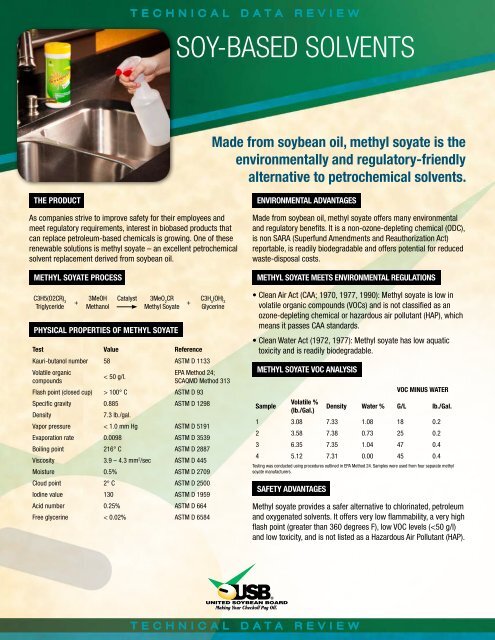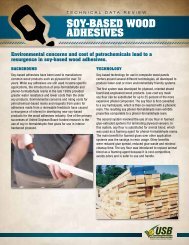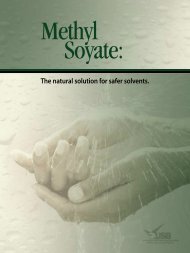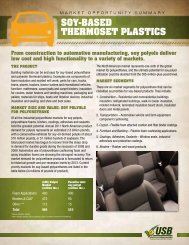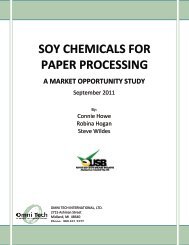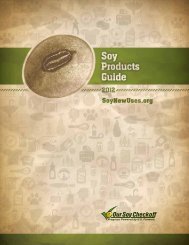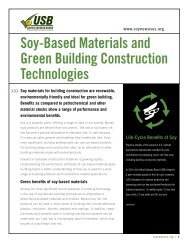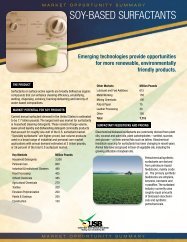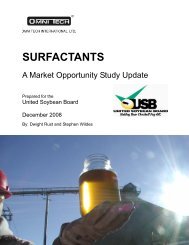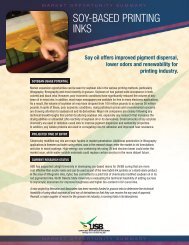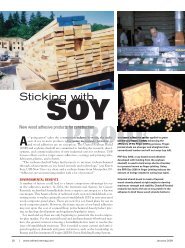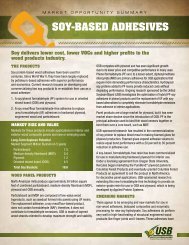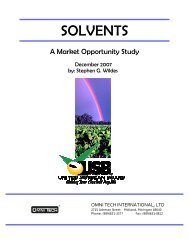You also want an ePaper? Increase the reach of your titles
YUMPU automatically turns print PDFs into web optimized ePapers that Google loves.
TECHNICAL DATA REVIEW<br />
<strong>SOY</strong>-<strong>BASED</strong> <strong>SOLVENTS</strong><br />
Made from soybean oil, methyl soyate is the<br />
environmentally and regulatory-friendly<br />
alternative to petrochemical solvents.<br />
THE PRODUCT<br />
As companies strive to improve safety for their employees and<br />
meet regulatory requirements, interest in biobased products that<br />
can replace petroleum-based chemicals is growing. One of these<br />
renewable solutions is methyl soyate – an excellent petrochemical<br />
solvent replacement derived from soybean oil.<br />
METHYL <strong>SOY</strong>ATE PROCESS<br />
C3H5(O2CR) 3<br />
Triglyceride<br />
+<br />
3MeOH<br />
Methanol<br />
Catalyst<br />
3MeO 2<br />
CR<br />
Methyl <strong>Soy</strong>ate<br />
PHYSICAL PROPERTIES OF METHYL <strong>SOY</strong>ATE<br />
Test Value Reference<br />
Kauri-butanol number 58 ASTM D 1133<br />
Volatile organic<br />
compounds<br />
< 50 g/l.<br />
+<br />
C3H 5<br />
(OH) 3<br />
Glycerine<br />
EPA Method 24;<br />
SCAQMD Method 313<br />
Flash point (closed cup) > 100° C ASTM D 93<br />
Specific gravity 0.885 ASTM D 1298<br />
Density<br />
7.3 lb./gal.<br />
Vapor pressure < 1.0 mm Hg ASTM D 5191<br />
Evaporation rate 0.0098 ASTM D 3539<br />
Boiling point 216° C ASTM D 2887<br />
Viscosity 3.9 – 4.3 mm 2 /sec ASTM D 445<br />
Moisture 0.5% ASTM D 2709<br />
Cloud point 2° C ASTM D 2500<br />
Iodine value 130 ASTM D 1959<br />
Acid number 0.25% ASTM D 664<br />
Free glycerine < 0.02% ASTM D 6584<br />
ENVIRONMENTAL ADVANTAGES<br />
Made from soybean oil, methyl soyate offers many environmental<br />
and regulatory benefits. It is a non-ozone-depleting chemical (ODC),<br />
is non SARA (Superfund Amendments and Reauthorization Act)<br />
reportable, is readily biodegradable and offers potential for reduced<br />
waste-disposal costs.<br />
METHYL <strong>SOY</strong>ATE MEETS ENVIRONMENTAL REGULATIONS<br />
• Clean Air Act (CAA; 1970, 1977, 1990): Methyl soyate is low in<br />
volatile organic compounds (VOCs) and is not classified as an<br />
ozone-depleting chemical or hazardous air pollutant (HAP), which<br />
means it passes CAA standards.<br />
• Clean Water Act (1972, 1977): Methyl soyate has low aquatic<br />
toxicity and is readily biodegradable.<br />
METHYL <strong>SOY</strong>ATE VOC ANALYSIS<br />
VOC MINUS WATER<br />
Sample<br />
Volatile %<br />
(lb./Gal.)<br />
Density Water % G/L lb./Gal.<br />
1 3.08 7.33 1.08 18 0.2<br />
2 3.58 7.38 0.73 25 0.2<br />
3 6.35 7.35 1.04 47 0.4<br />
4 5.12 7.31 0.00 45 0.4<br />
Testing was conducted using procedures outlined in EPA Method 24. Samples were used from four separate methyl<br />
soyate manufacturers.<br />
SAFETY ADVANTAGES<br />
Methyl soyate provides a safer alternative to chlorinated, petroleum<br />
and oxygenated solvents. It offers very low flammability, a very high<br />
flash point (greater than 360 degrees F), low VOC levels (
TECHNICAL DATA REVIEW<br />
<strong>SOY</strong>-<strong>BASED</strong> <strong>SOLVENTS</strong><br />
Methyl soyate toxicity:<br />
• Acute oral: LD 50<br />
> 5,000 mg/kg<br />
• Acute dermal: LD 50<br />
> 5,000 mg/kg<br />
• Skin irritation: 1.6 (nonirritating)<br />
Methyl soyate can replace:<br />
PERFORMANCE ADVANTAGES<br />
Because of its versatility, methyl soyate can be used to formulate<br />
many types of products. Typically, methyl soyate is formulated with<br />
co-solvents or surfactants to optimize product performance characteristics<br />
such as drying rate and water solubility.<br />
350<br />
300<br />
250<br />
200<br />
150<br />
100<br />
50<br />
0<br />
Methyl <strong>Soy</strong>ate Physical Properties<br />
% VOCs<br />
Flash Point °F<br />
KB Value<br />
Methyl <strong>Soy</strong>ate Mineral Spirits Toluene Naphtha D-Limonene<br />
MARKET APPLICATIONS FOR METHYL <strong>SOY</strong>ATE<br />
• Eye irritation: Nonirritating<br />
• Skin sensitization: Moderate<br />
potential<br />
• Mutagenicity: None<br />
(Ames assay)<br />
• Mineral spirits • Methyl ethyl ketone (MEK) • Methylene chloride<br />
• Trichloroethylene • Toluene • d-limonene<br />
Methyl soyate can be utilized in a number of different formulated<br />
products as a safe solvent replacement. Its excellent solvent properties<br />
make it adaptable to a wide range of performance requirements.<br />
• I&I (Institutional & Industrial) cleaning products – This market has<br />
emerged as the largest use segment for soy-based formulated<br />
cleaners. These cleaners are used in plant maintenance, restaurants,<br />
hospitals, schools and households to safely replace mineral<br />
spirits, chlorinated and citrus solvents as hard surface cleaners,<br />
general-purpose cleaners, glass cleaners, floor cleaners, bathroom<br />
cleaners, stainless steel cleaners and graffiti removers.<br />
• Parts cleaning and degreasing – Methyl soyate can replace petroleum<br />
and chlorinated solvents such as mineral spirits and trichloroethylene<br />
in industrial parts-cleaning processes. Other uses include automotive<br />
cleaners, food processing equipment cleaning and asphalt cleaners.<br />
• Paint, ink and adhesive removal – Applications include consumer<br />
and industrial paint strippers replacing methylene chloride; printing<br />
ink cleaners replacing toluene, adhesive and mastic removers;<br />
and graffiti removers replacing mineral spirits.<br />
• Petroleum product cleanup – Methyl soyate can be used for effective<br />
cleaning of oil spills on beaches and inland waters, as well as cleaning<br />
refinery reactors, storage tanks and processing equipment.<br />
• Carrier solvent – This developing use for methyl soyate involves alkyd<br />
paints, wood and concrete stains and corrosion protection products.<br />
• Consumer products – The safe properties of methyl soyate make<br />
it ideal for use in hand cleaners, skin lotions and other personal<br />
care products.<br />
• Fuels and lubricants – <strong>Uses</strong> for methyl soyate include lubricity<br />
additives, penetrating oils, metalworking fluids and form release<br />
agents for asphalt, concrete and metal fabrication. The largest<br />
use, however, is as the fuel base for biodiesel, which significantly<br />
reduces combustion emissions compared with petroleum diesel.<br />
EMERGING NEW USES AND APPLICATIONS<br />
The solvent market potential for soy solvents is not limited to<br />
the replacement of conventional solvents by methyl soyate.<br />
Methyl soyate can be used as a shoreline cleaner to remove and<br />
recover spilled oil and petroleum products from beaches and<br />
streams. It is listed by the U.S. EPA on the National Contingency<br />
Plan product schedule for oil spills and it is the only shoreline<br />
cleaner licensed by the state of California.<br />
Another creative new use for soy solvents is the safe disposal of<br />
waste plastic products. Methyl soyate can dissolve 20 to 25 times<br />
its own volume of plastic waste such as styrofoam flotation billets<br />
or shredded tire rubber. Dissolved scrap plastics have many use<br />
potentials such as paving product sealers and binders.<br />
Other new emerging applications for soy-based solvent products<br />
and processes include paper pulp cleaning and recycling,<br />
bioremediation, highway paving and patching materials and<br />
crude oil solvent extraction and processing.<br />
ABOUT USB<br />
USB is made up of 68 U.S. farmer-directors who oversee the<br />
investments of the soybean checkoff, a U.S. soybean research<br />
and promotion program, on behalf of all U.S. soybean farmers.<br />
Checkoff funds are invested in the areas of animal utilization,<br />
human utilization, industrial utilization, industry relations, market<br />
access and supply. As stipulated in the <strong>Soy</strong>bean Promotion,<br />
Research and Consumer Information Act, USDA’s Agricultural<br />
Marketing Service has oversight responsibilities for USB and the<br />
soybean checkoff.<br />
For more information, visit: soynewuses.org<br />
©2010 United <strong>Soy</strong>bean Board [38508-TSS-3/10]<br />
TECHNICAL DATA REVIEW


